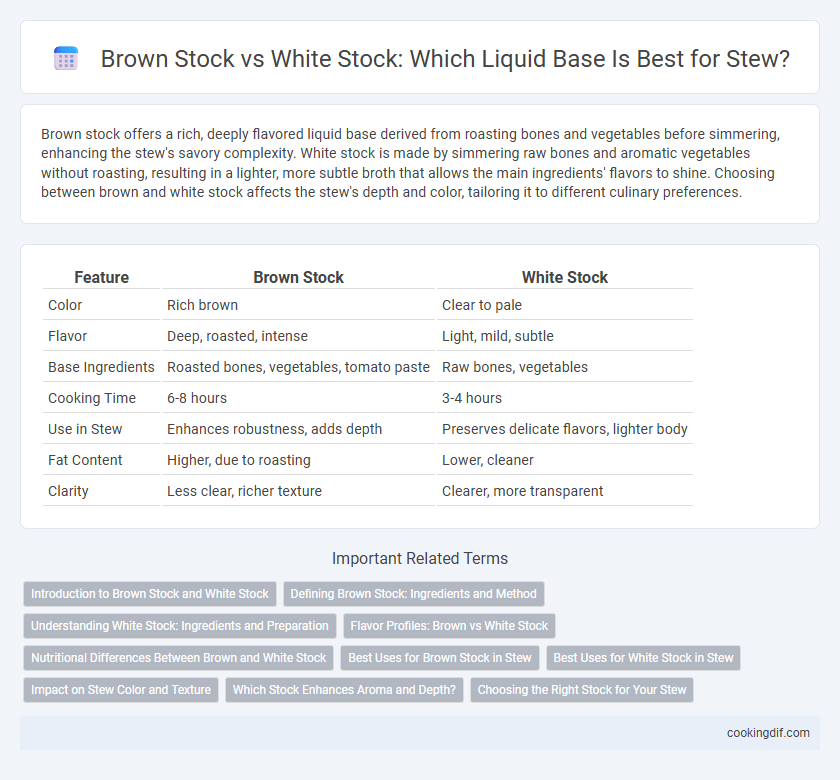Brown stock offers a rich, deeply flavored liquid base derived from roasting bones and vegetables before simmering, enhancing the stew's savory complexity. White stock is made by simmering raw bones and aromatic vegetables without roasting, resulting in a lighter, more subtle broth that allows the main ingredients' flavors to shine. Choosing between brown and white stock affects the stew's depth and color, tailoring it to different culinary preferences.
Table of Comparison
| Feature | Brown Stock | White Stock |
|---|---|---|
| Color | Rich brown | Clear to pale |
| Flavor | Deep, roasted, intense | Light, mild, subtle |
| Base Ingredients | Roasted bones, vegetables, tomato paste | Raw bones, vegetables |
| Cooking Time | 6-8 hours | 3-4 hours |
| Use in Stew | Enhances robustness, adds depth | Preserves delicate flavors, lighter body |
| Fat Content | Higher, due to roasting | Lower, cleaner |
| Clarity | Less clear, richer texture | Clearer, more transparent |
Introduction to Brown Stock and White Stock
Brown stock is a rich, deeply flavored liquid base made by simmering roasted bones and browned vegetables, resulting in a robust umami profile ideal for hearty stews. White stock is prepared by gently simmering raw bones and aromatic vegetables without browning, creating a light, clear broth that highlights delicate flavors. Both stocks serve as foundational liquids in stew preparation, influencing the stew's color, depth, and intensity.
Defining Brown Stock: Ingredients and Method
Brown stock is a rich, flavorful liquid base made by roasting bones, typically beef or veal, along with mirepoix (carrots, celery, onions) before simmering them in water for several hours. The roasting process caramelizes the natural sugars and enhances the depth of flavor, resulting in a darker, more robust stock compared to white stock. This method imparts complex, savory notes ideal for hearty stews and sauces that require an intense, umami-rich foundation.
Understanding White Stock: Ingredients and Preparation
White stock is made by simmering raw chicken, veal, or fish bones with vegetables such as onions, carrots, and celery, without roasting the bones, resulting in a clear, pale broth ideal for delicate stews. The absence of browning preserves a light flavor and color, making white stock a preferred choice for recipes requiring a subtle base liquid. Properly prepared white stock involves careful skimming of impurities during simmering to ensure clarity and a clean taste.
Flavor Profiles: Brown vs White Stock
Brown stock offers a richer, deeper flavor profile with caramelized, roasted notes derived from browned bones and vegetables, enhancing the stew's complexity and umami depth. White stock provides a lighter, cleaner taste with subtle vegetable and bone essences, creating a delicate base that allows other ingredients' flavors to shine. Choosing between brown and white stock significantly influences the stew's overall taste intensity and mouthfeel.
Nutritional Differences Between Brown and White Stock
Brown stock contains roasted bones and vegetables, which impart higher mineral content and richer flavor compounds compared to white stock made from raw ingredients. The Maillard reaction in brown stock enhances antioxidant levels and increases nutrient bioavailability, providing more B vitamins and trace minerals like calcium and magnesium. White stock, being lighter and less concentrated, offers lower calorie content but contains fewer complex nutrients and less gelatin, affecting the stew's texture and nutritional density.
Best Uses for Brown Stock in Stew
Brown stock, made from roasted bones and vegetables, delivers a rich, deep flavor and darker color, making it ideal for hearty stews with beef or game meats. Its robust umami profile enhances the savory complexity and adds body to slow-cooked dishes requiring long simmering times. Using brown stock in stew elevates the overall taste, providing depth that white stock, made from raw bones, cannot achieve.
Best Uses for White Stock in Stew
White stock, made from simmering raw chicken or veal bones, offers a light, delicate flavor ideal for clear, subtle stews where ingredient freshness is key. Its mild taste enhances the natural flavors of vegetables and herbs without overpowering the dish, making it perfect for poultry or seafood-based stews. White stock also provides a clear, less fatty liquid base that maintains the stew's vibrant appearance and allows for gentle seasoning adjustments.
Impact on Stew Color and Texture
Brown stock, made from roasted bones and vegetables, imparts a deep, rich color and robust flavor to stew, enhancing its visual appeal and providing a thicker, more gelatinous texture due to the higher collagen content. White stock, prepared from raw bones and vegetables without roasting, results in a lighter, clearer broth that creates a more delicate color and thinner texture in stew. Choosing brown stock intensifies the stew's heartiness and mouthfeel, while white stock offers a subtle, cleaner base that highlights other ingredients.
Which Stock Enhances Aroma and Depth?
Brown stock enhances aroma and depth more effectively than white stock due to its caramelized bones and roasted vegetables, which contribute rich, complex flavors and a deep, amber color. The Maillard reaction that occurs during browning intensifies the stock's savory profile, making it ideal for stews requiring robust umami notes. White stock, made from raw bones and vegetables, provides a lighter, more subtle base but lacks the pronounced aroma and flavor complexity found in brown stock.
Choosing the Right Stock for Your Stew
Brown stock enhances stew with rich, deep flavors derived from roasted bones and vegetables, creating a robust and savory base ideal for hearty meat stews. White stock, made from simmered raw bones and aromatics without roasting, offers a lighter, cleaner taste perfect for delicate stews featuring poultry or fish. Selecting the right stock depends on the stew's ingredients and desired flavor intensity to achieve optimal balance and depth.
Brown stock vs white stock for liquid base Infographic

 cookingdif.com
cookingdif.com